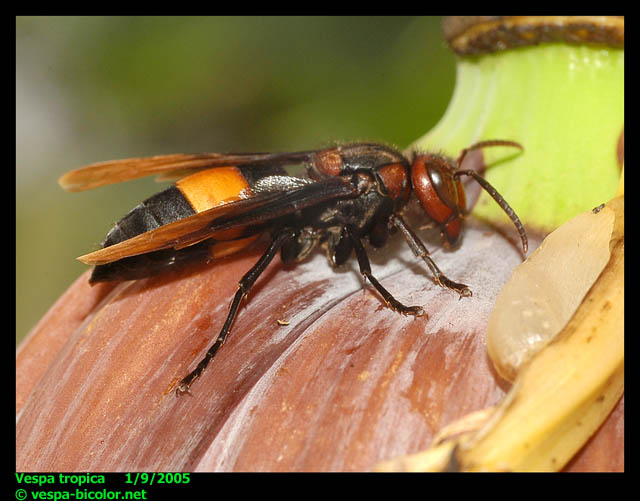

Above: Vespa tropica in Hong Kong
Below: Vespa tropica in Singapore. First photo copyright and courtesy of E-Trails Singapore (now defunct, link broken).
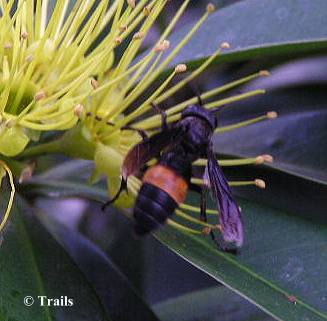
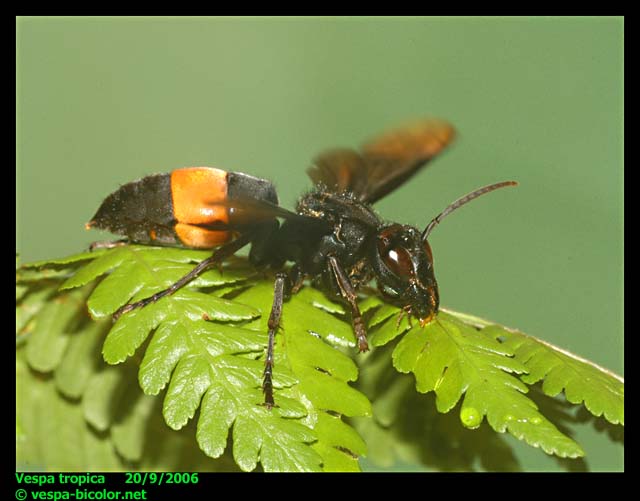

Vespa tropica is a widely distributed hornet in much of tropical Asia. In Hong Kong, it is not uncommon, but is rather secretive and tends to fly close to the cover of foliage, but not to the extent of Vespa analis However, will appear in the open to feed on fallen fruit in summer. Individuals in Singapore often fly high in trees.
This species is almost exclusively a predator on the brood of Polistines (paper wasps). The only instance of predation (as opposed to territorial fights) within the genus I witnessed also involved Vespa tropica; a large worker captured and killed an individual of Vespa bicolor.
The nest of Vespa tropica is usually underground or in a tree hollow or similar enclosed space. Due to the location, the nest is seldom seen. If excavated, the nest usually appears rhomboid or bowl-shaped, with an open bottom (as opposed to the completely sealed nests of most aerial hornets). The nest envelope is laminar (comprising of distinct, broad individual layers) and very brittle.
However, a nest probably of this species was photographed in an aerial location in Singapore, built from a tree! Photo copyright and courtesy of Tan Siong-Kiat (Singapore). The wasps can't be seen clearly in the photo but according to the description by Mr Tan in a personal communication, they had a band and were very large. Also, the envelope is more characteristic of Vespa tropica nests, being laminar and applied in sheet-like layers rather than being imbricate (with scalloped markings) as would be seen by the time a Vespa analis or Vespa analis nest reaches this size.
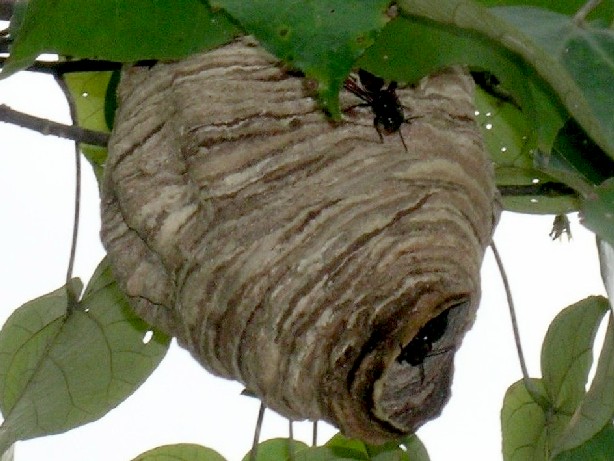
This apparently happens more often than expected. On my trip to Singapore in March 2006 (see the "Trip Reports" section), I found an extremely large nest of this species (nearly five feet in height and width!) in a tree! It was seven feet above ground, but had in fact fallen from an even higher position; its original location appeared to be at least 14 feet high.
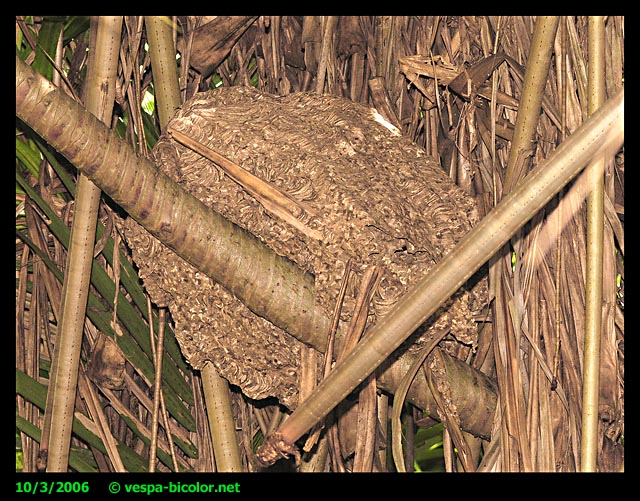
In Hong Kong, this species has a short life cycle. The queens emerge only in late May, and colonies die off by November.
In Hong Kong, Vespa tropica is moderately unaggresive unless nests are disturbed. A long time ago, when I was around 10, I found a hole in the ground, in which these wasps were emerging and flying away, while others returned. I was extremely curious and mischievous as a child, and despite my parents' stern warnings, I placed a plastic bag over the nest, hoping they would fly out and be trapped. To this day, I thank God that my life was so preserved! They could have killed me, but yet, all that happened was that activity at the nest halted. When I eventually moved off, the hornets started to emerge again. It is strange how reluctant these insects were to attack. But many years later, I performed nest relocations on this species and even kept observation colonies at home, and the workers attacked when provoked. I was even stung a couple of times, though this was always my fault. I was also once attacked in Singapore when I accidentally kicked a log concealing a nest.
It must also be noted that this species has been responsible for many fatal attacks, due to the location of its nests and its wide distribution. It is also known to have rather strong venom - in fact, the most painful single sting I have ever experienced was inflicted by a very large individual of this species in Singapore to my face - the intense pain and swelling lasted days and never really went away completely till 10 days later.
In my experience, this species, like Vespa affinis, appears more aggressive in tropical regions than sub-tropical areas; personal experience has shown colonies in Singapore to be much quicker to attack compared to those in Hong Kong, with a larger defensive radius.
In most parts of its range, Vespa tropica can easily be distinguished from Vespa affinis by its larger size and the distribution of the yellow band on the abdomen; the yellow band covers the first and second segments in Vespa affinis, but only the second in Vespa tropica.